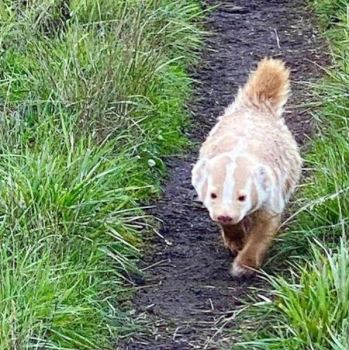
David Kramer was hiking on Nov. 26 in the Point Reyes National Seashore when he came across a startling sight: an American badger as pale as a bar of soap.
“I was on a 5-mile out-and-back (in Olema Valley) and just after I turned around at my halfway point, I noticed something on the trail ahead,” says Kramer, a nature photographer who lives in West Marin. “Once it came into full view, I realized what I was seeing. It was coming towards me on the trail and didn’t notice me at first, as I had stopped moving.”
Kramer just had time enough to whip out his phone and capture the above image of the white badger, which in his shot looks a little cranky. (Although badgers naturally seem to have resting-cranky faces.)
“It seemed like it was just traveling,” he says. “It came padding towards me at a good clip, and when it turned around, it kept going at the same speed until it got off into the bushes.”
Is this the Moby Dick of the badger world in Marin County? Well, it turns out the animal is not full albino. It probably is leucistic, a condition caused by a genetic mutation that results in partial loss of coloring. (Look closely and you’ll see its eyes are black-brown and its nose has some pigment.)

The Point Reyes National Seashore featured the unusual creature this week on its Facebook page, where it drew comments like “How exotic and dreamlike!” and “Filing this under ‘Things I have an urge to snuggle, which would be a terrible idea to snuggle.’” Wrote another person: “He looks like such a happy, cuddly chap skipping down the trail there.”
“I have worked here for over 25 years and have never heard of a leucistic or erythristic badger being seen here,” says David Press, a wildlife ecologist at Point Reyes National Seashore.
Wait, what’s that other word – erythristic?
“There have also been some suggestions that this could be an erythristic animal, in which fur or skin can have an unusual reddish pigment to it,” Press says. “In retrospect, we don’t know for sure whether the animal is leucistic or erythristic, but there is no question that this is a unique individual!”
It turns out this fellow is part of a very healthy badger population in West Marin, which has expanded into new areas over the past couple of decades.
“For example, there are more regular sightings of and evidence of badgers in the interior areas of the park, such as where this badger was observed,” Press says. “Badgers prefer open grassland and coastal scrub habitats. The large extent of these habitat types, with softer soils ideal for denning in and digging through, coupled with an abundance of prey such as gophers, meadow voles and other rodents, make Point Reyes an ideal area for badgers to thrive.”

If you want to try to spot one yourself, try checking out Point Reyes when the weather is chilly.
“Pierce Point Road is a good place to look,” Press suggests. “Badgers are most active at night, which makes them tough to see, of course. But they do like to come out and sun themselves on a cold day, so you never know.”
David Kramer says he regularly hikes at Point Reyes and has never encountered anything like this ghost badger.
“I’ve seen a lot of wildlife living here,” he says. “Probably the most exciting was a mountain lion 30 years ago. I regularly see bobcats and coyotes and lots of other animals while hiking in the park. Point Reyes is known to have some blue-eyed coyotes, and I have seen and photographed two of those.” (Check out Kramer’s nature photography at instagram.com/davidwkramer.)
